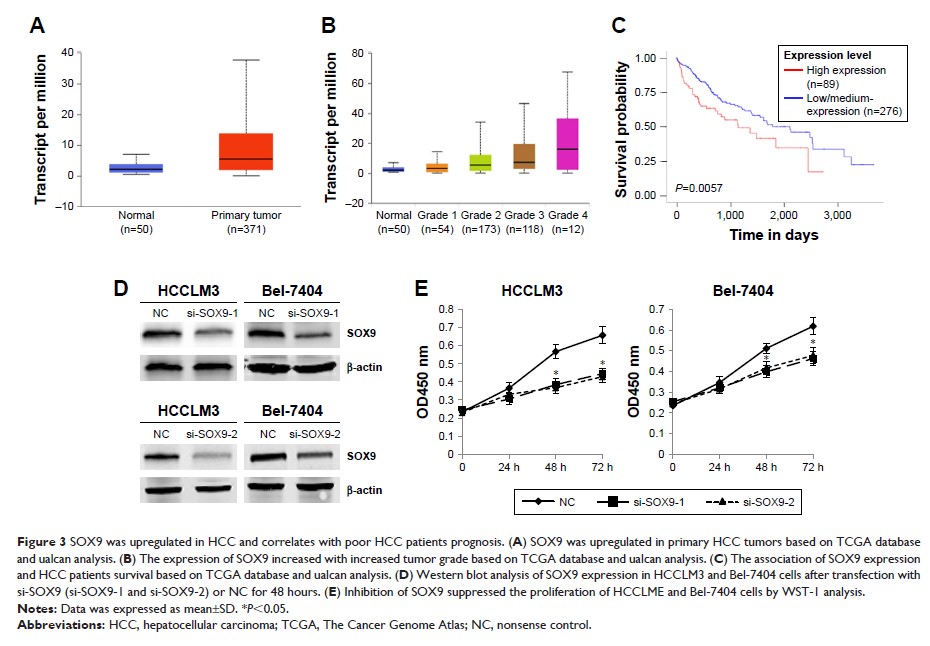9 7 8 1 6
论文已发表
注册即可获取德孚的最新动态
IF 收录期刊
- 3.3 Breast Cancer (Dove Med Press)
- 3.4 Clin Epidemiol
- 2.5 Cancer Manag Res
- 2.9 Infect Drug Resist
- 3.5 Clin Interv Aging
- 4.7 Drug Des Dev Ther
- 2.7 Int J Chronic Obstr
- 6.6 Int J Nanomed
- 2.5 Int J Women's Health
- 2.5 Neuropsych Dis Treat
- 2.7 OncoTargets Ther
- 2.0 Patient Prefer Adher
- 2.3 Ther Clin Risk Manag
- 2.5 J Pain Res
- 2.8 Diabet Metab Synd Ob
- 2.8 Psychol Res Behav Ma
- 3.0 Nat Sci Sleep
- 1.8 Pharmgenomics Pers Med
- 2.7 Risk Manag Healthc Policy
- 4.2 J Inflamm Res
- 2.1 Int J Gen Med
- 4.2 J Hepatocell Carcinoma
- 3.7 J Asthma Allergy
- 1.9 Clin Cosmet Investig Dermatol
- 2.7 J Multidiscip Healthc

miR-1-3p 通过靶向 SOX9 抑制肝细胞癌的增殖
Authors Zhang H, Zhang Z, Gao L, Qiao Z, Yu M, Yu B, Yang T
Received 6 December 2018
Accepted for publication 13 February 2019
Published 22 March 2019 Volume 2019:12 Pages 2149—2157
DOI https://doi.org/10.2147/OTT.S197326
Checked for plagiarism Yes
Review by Single-blind
Peer reviewers approved by Dr Amy Norman
Peer reviewer comments 3
Editor who approved publication: Dr William Cho
Background: Liver
cancer was the fourth leading cause of cancer-related death in 2015.
Hepatocellular carcinoma (HCC) is the most common type of liver cancer.
miR-1-3p plays important roles in cancer, including prostate, bladder, lung
cancer, and colorectal carcinoma. The function of miR-1-3p in HCC remains
poorly understood.
Methods: qRT-PCR
was performed to detect the miR-1-3p expression in HCC cell lines (HCCLM3,
Hep3B, Bel-7404, SMMC-7721) and the normal human hepatic cell line (LO2).
HCCLM3 and Bel-7404 cells were transfected with miR-1-3p mimic or scramble
control followed by water-soluble tetrazolium salt (WST-1) assay. Western bolt
analysis was performed to determine the protein levels. TargetScan7.1
(http://www.targetscan.org/vert_71/) was used to predict the potential targets
of miR-1-3p. SRY (sex determining region Y)-box 9 (SOX9), which has been
previously shown to play an important role in HCC, was found to be a target of
miR-1-3p. Luciferase reporter assay was used to explore the targeting of
miR-1-3p on SOX9. For in vivo tumorigenesis assay, HCCLM3 cells with
stable overexpression of miR-1-3p or control plasmid were injected
subcutaneously into the flank of the SCID mice and animals were monitored for
tumor growth.
Results: miR-1-3p
was significantly downregulated in HCC cell lines (HCCLM3, Hep3B, Bel-7404, and
SMMC-7721) compared to normal human hepatic cell line (LO2). Overexpression of
miR-1-3p significantly inhibited the proliferation and induced apoptosis in
HCCLM3 and Bel-7474 cells. SOX9 was a direct target of miR-1-3p in HCC cells.
Inhibition of SOX9 significantly inhibited the proliferation of HCCLM3 and
Bel-7474 cells. In vivo, overexpression of miR-1-3p decreased tumor volume
in a xenograft model.
Conclusion: These
results highlight the role of miR-1-3p in HCC. Overexpression of miR-1-3P
inhibited the proliferation of HCC at least partly due to the regulation of SOX9.
miR-1-3p may be a promising therapeutic candidate for HCC.
Keywords: miR-1-3p,
hepatocellular carcinoma, SOX9, proliferation, apoptosis
